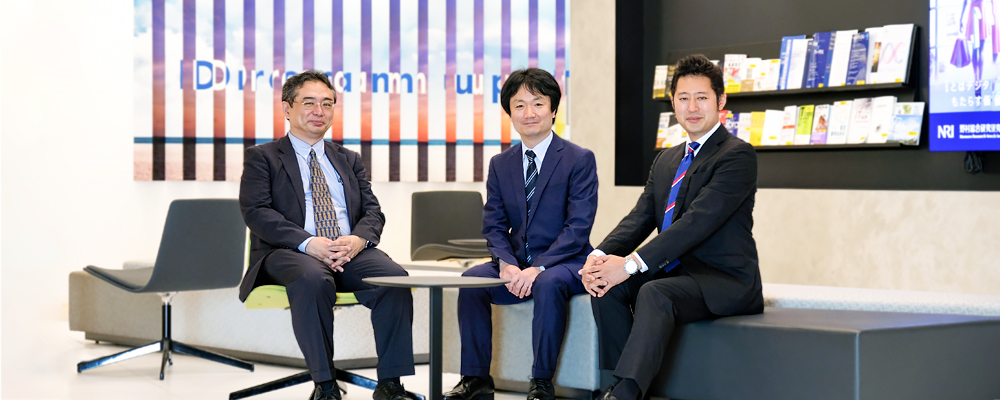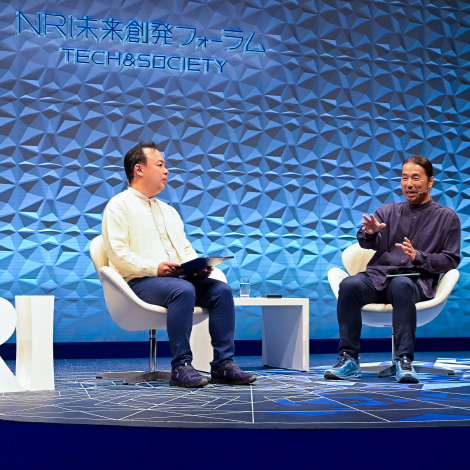Resilient Smart Cities: Towards Realizing Safe, Comfortable Cities in an Era Living With COVID-19 and After COVID-19
#Smart City
Aug. 14, 2020
Through use of digital technology, smart cities aim to optimize city infrastructure and facilities, operational work, and the like, and to improve convenience and comfort for companies and residents. As smart cities move from the conceptualization phase to the actualization phase, what kind of impact will the COVID-19 pandemic have? We asked NRI urban planning and smart city experts Takamasa Mataki, Keitaro Ishigami, and Eiichiro Takami about the present state of smart cities and the challenges being faced.
Using smart technology to respond to new needs arising from the COVID-19 pandemic
--- Has there been any change in the past year in efforts relating to smart cities?
We feel that in the latter half of 2019, there was a shift from a phase of building the concept of a smart city to a phase of thinking concretely about city design, necessary infrastructure, data acquisition methods, and achievable business. As the level of specificity increased, more in-depth challenges came to light. For example, how to merge and differentiate super applications, which enable use of all kinds of daily life-related services, and individual portal applications (city applications) for each city, or what kind of smart infrastructure can we design for a small area of just a few hundred to a few thousand hectares.
--- Because of the COVID-19 pandemic, we now have more opportunities to experience a new lifestyle. Will this have any impact on our approach to smart cities?

Cities form in the first place because there are advantages to integration, but they breed problems such as population concentration, environmental degradation, and long commutes. Until now, we have been looking into infrastructure and services optimized through smart technologies using ICT, AI, IoT, and the like in order to solve these problems in cities and improve quality of life. Then, the COVID-19 pandemic brought about new needs, namely, that people want to live in safety and comfort while avoiding the “three Cs” (closed spaces, crowded places, and close-contact settings) and preventing spread of the virus.
In response to these new needs, we saw a rediscovery of the potential to apply conventional smart technology, involving tracking and analysis of mobile data and personal data, as-is to the purposes of managing contact trails and issuing alerts. We have also had the opportunity to conceive of new standards required for resilient smart cities in the age of living with COVID-19 and after COVID-19, such as standardized incorporation of such new functions.

Challenges include securing digital general contractor functions and making “smart X” profitable
--- What are some important challenges to address in creating cities that are resilient towards infectious diseases?
I’ve always said this, but securing a “digital general contractor function” that links equipment, data, systems, and activities in the city is critically important. In bringing smart cities to life, we must combine a multitude of elements, such as ICT and digital functions, construction and design functions, heavy electric and engineering functions, and the like, and so in the actualization phase the need for a role that combines all of these elements into a whole has become ever more clear. For example, Sidewalk Labs, which is under the same parent company as Google, uses external human resources, and Singapore’s ST Engineering brought together related group companies, each thus forming a digital general contractor team. These examples can serve as a reference for thinking about how to organize participating players in Japan.

Another issue on the table in the actualization phase is how to make a profit. Creating smart cities first involves long-term investment in land, equipment, and machinery of a scale vastly exceeding stand-alone investment in a high-speed railway or thermal power plant. Meanwhile, we can expect to gain revenue from operating expenses and municipal expenditures, and there is room to create various revenue opportunities. We need to pursue revenue opportunities in each of the “smart X” ventures that will serve as the components of a city—smart energy, smart mobility, smart buildings, and other smart infrastructure, and city applications, super applications, and other elements of smart life—and establish these as a form of business.
If we work within a single company or group like Sidewalk Labs and ST Engineering, we can take an approach where departments running a deficit are covered by departments making a profit, but if various external players are involved, we need to think about how to design an ecosystem where each player displays its strengths in its area of expertise and brings in a profit.
Creating a new lifestyle with a sense of speed
--- Tell us about the future prospects for smart cities.

This depends on whether the new normal will be vastly different from the past, or not, but if we leverage smart technology wisely, it’s certain that we will be able to achieve a safer and more comfortable lifestyle either way. In a city formed by “smart X”, data can be acquired in ways differing from conventional ways, and various experiments can be carried out, so the nature of companies’ research and development and infrastructure management may also change significantly. For companies, even if no short-term profit can be expected, it’s worth putting in effort with an eye on medium-to-long-term outcomes.
However, I’ve seen many companies that are interested in smart cities and consider getting involved, but are unable to take the next step. In order to take advantage of the situation and turn the COVID-19 pandemic into an opportunity, I hope to see more companies start to experiment and get involved at this timing with a sense of speed matching that in other countries, and we also intend to support such companies in doing so.







